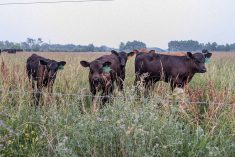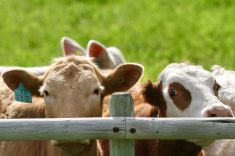LACOMBE, Alta. — Some of the high costs of supplying cows with winter feed can be reduced with common sense planning.
“Low cost production does not mean not feeding them, it means being smart about the decisions you make,” said John Basarab of Alberta Agriculture and the Western Forage Beef Group.
Between 60 and 65 percent of the cost of beef production is rooted in winter feed expenses.
Cost and production are related to profits on a cow-calf operation, he told those attending the forage group’s annual pasture school in Lacombe.
Read Also

U.S. farm group supports supply management
U.S. grassroots farm advocacy group pushing new agriculture legislation that would move towards supply management like Canada has for dairy industry
An increasingly popular way to shave winter feed costs is to encourage cows to graze year round. This is cheaper because it eliminates the costs of mechanical harvest, feed hauling and manure handling.
It can be accomplished with stockpiled forage grown in the summer and saved for grazing in the fall.
The summer months from June to September are the best pasture season and are good for milk production.
Cows that are fattening can be turned out on stockpiled forage from September to November.
“Grow enough forage in the summer with a rest period of about six weeks. Species with good regrowth work really well,” Vern Baron told the group.
Orchard grass works well in central Alberta compared to drier areas where crested wheat grass or russian wildrye grass are good choices.
During the winter months of November to February, cows live off their fat and are relatively cheap to feed with swath grazing and some supplemental feed.
It is also important to remember every operation is different, with a wide range of challenges due to climate, topography, management concepts and cow genetics.
It is wise to match the cow type to the location.
Studies have shown that British and smaller British cross cows are optimal in semi-arid climates where there is a limited feed resource. For example, in southeastern Alberta, a smaller cow with moderate milk production fares better than a larger framed type.
British and medium-sized continental crosses do well in a semi-arid climate where there are medium levels of feed resources. British and large continental crosses work well where precipitation is adequate and feed resources are abundant.
There is wide variability within a single herd of cows of the same breed. Individual animal variation in the energy cost of maintenance could vary by 30 to 50 percent.
Cows require nutrients for maintenance, lactation, growth and reproduction. An animal’s first priority is its own maintenance.
The last trimester of pregnancy and early stages of lactation place the highest demand for energy on the cow. It needs high quality pasture to keep milking and raise a good sized, healthy calf.
Going into the fall, each cow’s body condition should be observed because this is the time she should start putting on fat to carry her through the winter when feed supplies change. Fattening up a cow in the winter months is too expensive.
To bring up her condition score by one point requires 1,200 pounds of barley or 2,000 lb. of hay.
Alberta has a competitive advantage for raising cows because the mean temperature is around the freezing mark, said Baron. This also helps control winter costs.
“As it gets colder, you do require more energy intake by the animals to maintain condition and maintain core temperatures,” he said. When it gets colder than -15 C, more energy is required to keep warm.
“We may need to supplement when the temperatures get colder because the cow is compromised,” said Baron.















